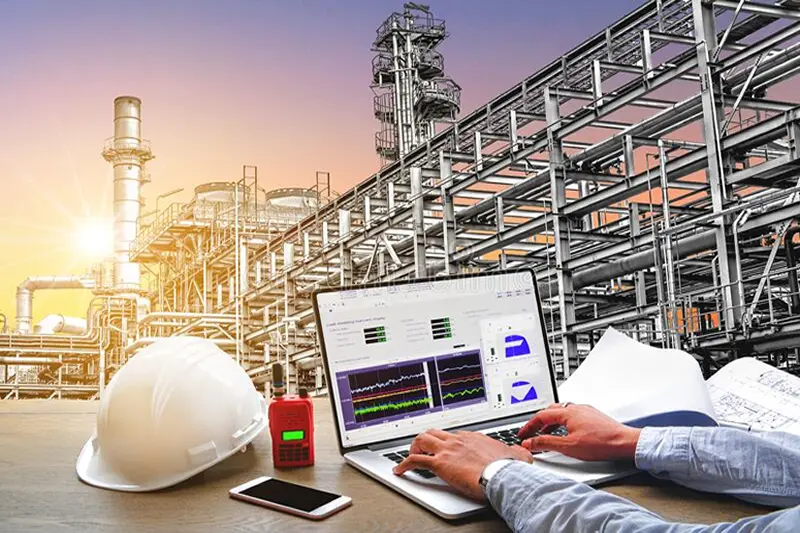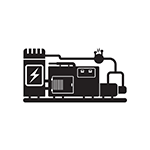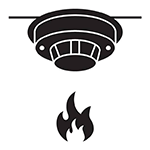
Engineering Services
Building Maintenance is a core text on the technical aspects of maintenance particularly in facilities management. A professional approach is required to building maintenance By encouraging maintenance team to stand back and take a strategic view of building maintenance alongside their day-to-day tasks.
We Serve the best Services
- Electrical Distribution System
- Power Generation Systems like DG Sets
- Compressed Air Systems
- HVAC Systems
- Water Treatment & Effluent Treatment Systems
- Fire Protection and Fire Fighting Systems
- Fuel Handling Systems
- Material Handling Systems
- Steam Generation
- Systems
- Carpentry
The main function of an Electrical Power Distribution system is to provide power to individual consumer premises. Distribution of electric power to different consumers is done with much low voltage level. Distribution of electric power is done by distribution networks. Distribution networks consist of following main parts
Little attention or thought is given to these critical assets until a failure occurs. With a little thought and planning for maintenance, most electrical system failures can be eliminated.
You've probably heard the athlete's proverb, "No pain, no gain." In the electrical world, it's "No maintenance, no operations." How much maintenance do you need?
Your power distribution system is your backbone. Unfortunately, many organizations operate on the "if it ain't broke, don't fix it" principle. Thus, many companies underfund (and undermine) their maintenance departments. As a result, maintenance groups routinely make emergency repairs at excessive cost. You may have been in such a situation. And you may have said, "Now they'll listen to us. Now we'll do the maintenance we need to do."
Will your company ensure timely completion of maintenance and repairs for more than an hour after the crisis has passed? Unfortunately, the answer is usually no. The predictable result is more unplanned downtime.
What about those organizations with comprehensive preventative/predictive maintenance programs? Every electrical and mechanical device undergoes scheduled inspections and maintenance. Skilled maintenance people identify and repair potential equipment problems before they become major events. This approach actually builds the bottom line. Feel fortunate if your company prescribes to this maintenance style.
- Distribution substation
- Primary distribution feeder
- Distribution Transformer
- Distributors
- Service mains
Little attention or thought is given to these critical assets until a failure occurs. With a little thought and planning for maintenance, most electrical system failures can be eliminated.
You've probably heard the athlete's proverb, "No pain, no gain." In the electrical world, it's "No maintenance, no operations." How much maintenance do you need?
Your power distribution system is your backbone. Unfortunately, many organizations operate on the "if it ain't broke, don't fix it" principle. Thus, many companies underfund (and undermine) their maintenance departments. As a result, maintenance groups routinely make emergency repairs at excessive cost. You may have been in such a situation. And you may have said, "Now they'll listen to us. Now we'll do the maintenance we need to do."
Will your company ensure timely completion of maintenance and repairs for more than an hour after the crisis has passed? Unfortunately, the answer is usually no. The predictable result is more unplanned downtime.
What about those organizations with comprehensive preventative/predictive maintenance programs? Every electrical and mechanical device undergoes scheduled inspections and maintenance. Skilled maintenance people identify and repair potential equipment problems before they become major events. This approach actually builds the bottom line. Feel fortunate if your company prescribes to this maintenance style.
Diesel generator sets – used for either prime or backup (emergency) power – must be regularly maintained to ensure they provide quality power throughout their service life.
arger companies who own many generators, or those who rely on gensets extensively for prime power, may require an in-house engineer to maintain their gensets.
Smaller companies, or users who own a generator to provide backup power in the event of an outage, may establish maintenance contracts with generator dealers and/or electrical contractors to maintain their gensets.
In either instance, the life-cycle of power generators is well established and documented making routine maintenance fairly straight-forward.
Best generator maintenance practice is following the maintenance schedule provided by the manufacturer of the generator.
The long outstanding use of generators over time has provided the necessary knowledge to predict when certain components will fail or be in need of service.
A fairly reliable maintenance schedule can usually be acquired from the manufacturer and can be employed by a local generator dealer or other electrical contractors/engineers with experience in power generation.
Adhering to this schedule will ensure maximum service time for the generator and proper operation when it is called upon to provide power. Large generator manufacturers have established maintenance plans and will not only service their own generators, but many of the other industries major brand names as well.
For individual households, such power outages are often just an inconvenience. For hospitals and other health-care facilities, however, they can be life-threatening. For businesses like data centers, these outages can be extremely costly.
arger companies who own many generators, or those who rely on gensets extensively for prime power, may require an in-house engineer to maintain their gensets.
Smaller companies, or users who own a generator to provide backup power in the event of an outage, may establish maintenance contracts with generator dealers and/or electrical contractors to maintain their gensets.
In either instance, the life-cycle of power generators is well established and documented making routine maintenance fairly straight-forward.
Best generator maintenance practice is following the maintenance schedule provided by the manufacturer of the generator.
The long outstanding use of generators over time has provided the necessary knowledge to predict when certain components will fail or be in need of service.
A fairly reliable maintenance schedule can usually be acquired from the manufacturer and can be employed by a local generator dealer or other electrical contractors/engineers with experience in power generation.
Adhering to this schedule will ensure maximum service time for the generator and proper operation when it is called upon to provide power. Large generator manufacturers have established maintenance plans and will not only service their own generators, but many of the other industries major brand names as well.
For individual households, such power outages are often just an inconvenience. For hospitals and other health-care facilities, however, they can be life-threatening. For businesses like data centers, these outages can be extremely costly.
Like all electro-mechanical equipment, industrial compressed air systems require periodic maintenance to operate at peak efficiency and minimize unscheduled downtime.
Inadequate maintenance can have a significant impact on energy consumption via lower compression efficiency, air leakage, or pressure variability. It can also lead to high operating temperatures, poor moisture control, and excessive contamination.
Most problems are minor and canbe corrected by simple adjustments, cleaning, part replacement, or the elimination of adverse conditions.
Compressed air system maintenance is similar to that performed on cars; filters and fluids are replaced, cooling water is inspected, belts are adjusted, and leaks are identified and repaired.
All equipment in the compressed air system should be maintained in accordance with manufacturers’ specifications.
Manufacturers provide inspection, maintenance, and service schedules that should be followed strictly.
In many cases, it makes sense from efficiency and economic standpoints to maintain equipment more frequently than the intervals recommended by manufacturers, which are primarily designed to protect equipment.
Inadequate maintenance can have a significant impact on energy consumption via lower compression efficiency, air leakage, or pressure variability. It can also lead to high operating temperatures, poor moisture control, and excessive contamination.
Most problems are minor and canbe corrected by simple adjustments, cleaning, part replacement, or the elimination of adverse conditions.
Compressed air system maintenance is similar to that performed on cars; filters and fluids are replaced, cooling water is inspected, belts are adjusted, and leaks are identified and repaired.
All equipment in the compressed air system should be maintained in accordance with manufacturers’ specifications.
Manufacturers provide inspection, maintenance, and service schedules that should be followed strictly.
In many cases, it makes sense from efficiency and economic standpoints to maintain equipment more frequently than the intervals recommended by manufacturers, which are primarily designed to protect equipment.
The approach to maintenance with respect to HVAC systems is particularly troubling given the role that HVAC systems play in today’s facilities.
HVAC systems in typical commercial buildings are responsible for more than 40 percent of total energy use. Keeping HVAC systems running properly and at peak efficiency is the first step in managing facility energy use.
The importance of good HVAC system maintenance goes beyond just controlling energy use. Buildings today depend on properly operating systems for more than just people comfort.
For example, most telecommunications systems have requirements for specific environmental conditions to operate properly.
Temperatures and humidity levels that fall outside of this range can lead to interruption in services and even costly system failures.
Sometimes the difference between keeping a business running and having to shut down is nothing more than proper HVAC system maintenance.
Maintaining your HVAC systems not only protects the equipment – it also protects the people in your building from discomfort and IAQ concerns, and protects you from a lawsuit.
There are many ways to make sure that indoor air is kept at appropriate levels:
Keep an eye on the air vents – you can find out if mould or other pollutants are entering your occupied space.
Watch for a musty odor.
Keep in touch with tenants/occupants, and ask them to participate in surveys regarding air quality.
Listen to people’s complaints and take them seriously.
In addition to keeping IAQ in check, routine maintenance can also lower utility costs and reduce equipment-replacement costs.
HVAC systems in typical commercial buildings are responsible for more than 40 percent of total energy use. Keeping HVAC systems running properly and at peak efficiency is the first step in managing facility energy use.
The importance of good HVAC system maintenance goes beyond just controlling energy use. Buildings today depend on properly operating systems for more than just people comfort.
For example, most telecommunications systems have requirements for specific environmental conditions to operate properly.
Temperatures and humidity levels that fall outside of this range can lead to interruption in services and even costly system failures.
Sometimes the difference between keeping a business running and having to shut down is nothing more than proper HVAC system maintenance.
Maintaining your HVAC systems not only protects the equipment – it also protects the people in your building from discomfort and IAQ concerns, and protects you from a lawsuit.
There are many ways to make sure that indoor air is kept at appropriate levels:
Keep an eye on the air vents – you can find out if mould or other pollutants are entering your occupied space.
Watch for a musty odor.
Keep in touch with tenants/occupants, and ask them to participate in surveys regarding air quality.
Listen to people’s complaints and take them seriously.
In addition to keeping IAQ in check, routine maintenance can also lower utility costs and reduce equipment-replacement costs.
Some of the major important types of wastewater treatment process are as follows:
It is estimated that every year 1.8 million people die due to suffering from waterborne diseases. A large part of these deaths can be indirectly attributed to improper sanitation.
Wastewater treatment is an important initiative which has to be taken more seriously for the betterment of the society and our future. Wastewater treatment is a process, wherein the contaminants are removed from wastewater as well as household sewage, to produce waste stream or solid waste suitable for discharge or reuse. Wastewater treatment methods are categorized into three sub-divisions, physical, chemical and biological.
- Effluent Treatment Plants (ETP)
- Sewage Treatment Plants (STP)
- Common and Combined Effluent
- Treatment Plants (CETP).
It is estimated that every year 1.8 million people die due to suffering from waterborne diseases. A large part of these deaths can be indirectly attributed to improper sanitation.
Wastewater treatment is an important initiative which has to be taken more seriously for the betterment of the society and our future. Wastewater treatment is a process, wherein the contaminants are removed from wastewater as well as household sewage, to produce waste stream or solid waste suitable for discharge or reuse. Wastewater treatment methods are categorized into three sub-divisions, physical, chemical and biological.
General Fire Fighting Equipment
Fire fighting systems and equipment vary depending on the age, size, use and type of building construction. A building may contain some or all of the following features:
Fire fighting systems are those which intervene in the fire growth process. Such systems can be used by trained occupants or attending firefighters and include a fire extinguisher, fire hose reel, or fire hydrant.
Other systems may be automatic such as a fire sprinkler system. Automatic systems are considered to be superior, because they do not rely on people to manually operate them. Fire fighting systems are known as "DYNAMIC" systems because they do something; they actively intervene in the rate of fire growth.
The greater the extinguishing capability of the system and the earlier in the fire growth period it can be applied, the lower the fire impact, hence, the preference for sprinkler systems by most fire engineers and firefighting professionals.
Fire Detection Alarm and Evacuation Warning Systems
The simplest fire detection and alarm system is the residential smoke alarm now installed in most Australian homes. The smoke alarm alerts the building occupants that a fire has been detected. A fire detection system may, in addition to alerting occupants, automatically notify the fire brigade of the fire. If fire detection and alarm systems operate very early in the fire growth stage, building occupants may be able to extinguish a small fire.
An evacuation warning system may be activated by a fire detection or firefighting system or manually by a chief fire warden for other circumstances such as a bomb threat. Many evacuation warning systems also have an intercommunication system such as a phone system and/or a public address system which can be used to pass information to the building occupants and fire wardens, who will orchestrate an orderly evacuation, or move occupants to safer parts of the building.
Fire fighting systems and equipment vary depending on the age, size, use and type of building construction. A building may contain some or all of the following features:
- Fire extinguishers
- Fire hose reels
- Fire hydrant systems
- Automatic sprinkler systems
- Fire Fighting Systems
Fire fighting systems are those which intervene in the fire growth process. Such systems can be used by trained occupants or attending firefighters and include a fire extinguisher, fire hose reel, or fire hydrant.
Other systems may be automatic such as a fire sprinkler system. Automatic systems are considered to be superior, because they do not rely on people to manually operate them. Fire fighting systems are known as "DYNAMIC" systems because they do something; they actively intervene in the rate of fire growth.
The greater the extinguishing capability of the system and the earlier in the fire growth period it can be applied, the lower the fire impact, hence, the preference for sprinkler systems by most fire engineers and firefighting professionals.
Fire Detection Alarm and Evacuation Warning Systems
The simplest fire detection and alarm system is the residential smoke alarm now installed in most Australian homes. The smoke alarm alerts the building occupants that a fire has been detected. A fire detection system may, in addition to alerting occupants, automatically notify the fire brigade of the fire. If fire detection and alarm systems operate very early in the fire growth stage, building occupants may be able to extinguish a small fire.
An evacuation warning system may be activated by a fire detection or firefighting system or manually by a chief fire warden for other circumstances such as a bomb threat. Many evacuation warning systems also have an intercommunication system such as a phone system and/or a public address system which can be used to pass information to the building occupants and fire wardens, who will orchestrate an orderly evacuation, or move occupants to safer parts of the building.


 Electrical Distribution System
Electrical Distribution System
 Power Generation Systems like DG Sets
Power Generation Systems like DG Sets
 Compressed Air Systems
Compressed Air Systems
 HVAC Systems
HVAC Systems
 Water Treatment & Effluent Treatment Systems
Water Treatment & Effluent Treatment Systems
 Fire Protection and Fire Fighting Systems
Fire Protection and Fire Fighting Systems